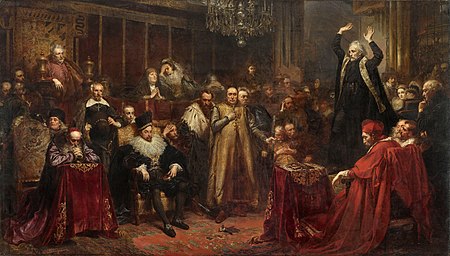Skarga's Sermon
| Kazanie Skargi | |
|---|---|
 |
|
| Artist | Jan Matejko |
| Year | 1864 |
| Medium | Oil on canvas |
| Dimensions | 224 cm × 397 cm (88 in × 156 in) |
| Location | National Museum, Warsaw |
The Sermon of Piotr Skarga or Skarga's Sermon (Polish: Kazanie Skargi) is a large oil painting by Jan Matejko, finished in 1864, now in the National Museum, Warsaw in Poland. It depicts a sermon on political matters by the Jesuit priest Piotr Skarga, a chief figure of the Counter Reformation in Poland, where he rebukes the Polish elite for neglecting the national interest.
Skarga's Sermon is among Matejko's most famous works, and like other historical paintings by Matejko includes several portraits of identifiable historical figures of the period depicted, as well as in this case a self-portrait of the artist in the figure of Skarga.
Matejko finished the painting in May 1864. It was the first "large" painting of Matejko (the canvas had the size of over 8 square metres (86 sq ft), several times larger than any of his prior work). It was displayed in the gallery of the Kraków Society of Friends of Fine Art (Towarzystwo Przyjaciół Sztuk Pięknych w Krakowie). Painting's premiere drew crowds and reviews comparable with modern movie premieres. Soon afterwards Count Maurycy Potocki bought it for 10,000 guldens.
The painting shows Poland of the early 17th century, a country torn between the magnates and elected kings of the House of Vasa, with a proud and egotistical nobility, beginning a slide into an ungovernable anarchy. In that context, little heed was paid to the calls of many individuals (such as Skarga) for reform. Matejko's work became one of the major elements of the "legend of Piotr Skarga", helping the Jesuit achieve a lasting fame in Poland. Although Matejko's work fits within the genre of historical painting, with the Sermon... he departed from strict adherence to historical accuracy, focusing more on the message; thus this painting, like many of his subsequent works, included characters or items that could not have been present at the depicted scene.
...
Wikipedia
